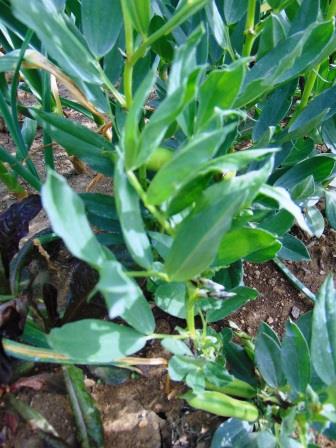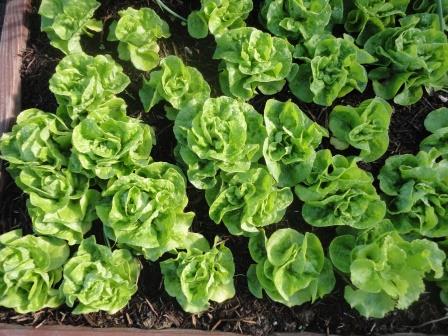I’ve been finalizing the spring planting plan for the potager. It’s a lot easier to move crops around on paper and make good decisions than it is outdoors in the heady rush of spring. Good planning makes sure that succession crops go in on schedule (with a nod to weather, of course) but in order to do that, good record keeping of not only when crops went in, but when they went out really helps. For instance, shallots generally come out sometime before mid-July which is a perfect time for parsnip seed and brussel sprout plants to go in (here in Zone 5…it could be different where you live.) Sometimes it’s a tight squeeze time-wise and the weather doesn’t cooperate. Then decisions have to be made on the fly, but the more planning that can be completed in the calm of winter the better. Still, the problem can be that crops don’t come out quickly enough. New crops need to go in, but there’s no empty space. Here’s my current thinking to help remedy that situation.
Today’s topic is interplanting. Long-time readers will know that radish seeds are always mixed with slower germinating crops like carrots and kohlrabi in the Herbal Blessings potager. They emerge to mark rows quickly and are ready to harvest in only 3 weeks! This also saves a lot of thinning time, and means not wasting seeds of carrots, etc. (Plus I have trouble killing baby plants intentionally.) And it means that radishes never require their own row, which allows for more crops in the potager’s limited space.  Last year I experimented with more interplanting to save space. Onion sets were planted with fava beans and aspa-broc. Both worked exceptionally well. As the favas and aspa-broc plants grew larger, the onions were harvested as scallions, working outward from the ever expanding shade. When the favas and aspa-broc’s full-size was reached, the remaining onions left in relative sun were left to mature. Win-win. And, as a bonus there seemed to be fewer insects on the beds with the onions than on the beds without.
Last year I experimented with more interplanting to save space. Onion sets were planted with fava beans and aspa-broc. Both worked exceptionally well. As the favas and aspa-broc plants grew larger, the onions were harvested as scallions, working outward from the ever expanding shade. When the favas and aspa-broc’s full-size was reached, the remaining onions left in relative sun were left to mature. Win-win. And, as a bonus there seemed to be fewer insects on the beds with the onions than on the beds without.
This year, there will be more experiments. I dislike seeing bare ground around slow-growing plants, so this year all the cabbage and cauliflower will be surrounded by onion plants. Now there can be plenty of grilled scallions early on, but onions for storing all winter as well without a dedicated onion bed!
Squash plants will get a carrot underplanting. Doesn’t it bother you to see a big square of empty soil surrounding that one little squash plant? Of course it’s going to need that entire square eventually, but what about in the meantime? Lots of good eating can come from that space while one waits. And what if those tall squash leaves prevent those pesky carrot flies from circulating? I get excited just thinking about it.
Somewhere last year I read, and made a note stuck in last year’s planting journal that broccoli likes growing with beets. I love growing beets for pickling and roasting, and finding enough space is always a challenge. Planting rows of beets amid the broccoli should provide those tiny early beets pulled whole to saute with a bit of butter, slightly larger ones whose greens and roots (scrubbed and quartered but left raw) for salads, and eventually, full-sized beets for roasting and pickling.
 And, there will be more intentional harvesting. I love planting small blocks of “Tom Thumb” and “Little Gem” lettuces. This year instead of a designated bed for lettuce there will be nine adorable plants in a tidy little square (3-3-3) or ten in a perfect triangle (4-3-2-1) in the corners of the potager’s large squares. I’ll harvest one from the center and stick in a young pepper, eggplant, or tomato plant. Continue harvesting lettuces as the newcomer grows and viola! No wasted space!
And, there will be more intentional harvesting. I love planting small blocks of “Tom Thumb” and “Little Gem” lettuces. This year instead of a designated bed for lettuce there will be nine adorable plants in a tidy little square (3-3-3) or ten in a perfect triangle (4-3-2-1) in the corners of the potager’s large squares. I’ll harvest one from the center and stick in a young pepper, eggplant, or tomato plant. Continue harvesting lettuces as the newcomer grows and viola! No wasted space!
I’m going to be looking at other combinations and possibly revising some of my planting scheme. Already the interplanting plan has “freed” up some rows so additional crops can be added! Whee! Now I can move a few items from the “Wish” list to the “Order” list! What interplanting strategies and combinations have worked for you?
NOTE: As with any intensive planting, interplanting will require excellent soil fertilization and careful attention to watering.

I love planning. I love lists, spreadsheets, and diagrams. I also love my garden. Putting the two together is one of the happiest days of the year for me.
LikeLike
I feel exactly the same way! Not so crazy about spreadsheets, but I love notebooks and blank sheet of paper!
LikeLiked by 1 person
My sister likes to make fun of my love for spreadsheets, but they are really helpful when you have 5 kids and need to pack for a family trip.
LikeLiked by 1 person
Genius!
LikeLike
Sounds good in theory, but still to be proven if it all works properly! Thanks for reading!
LikeLiked by 1 person
I put melons under my tomatoes to maximize space and it worked really well last year- I’m not as organized as you to plan as well as you do, but this is great food for thought!
LikeLiked by 1 person
This sounds like such a good idea, I have two raised beds at the moment so I am tight on space as well. Do you sow the carrot and radish seeds (for example) at the same time, together in a drill?
LikeLike
Yes, I mix them together and then sprinkle as carefully as I can in a row.
LikeLike